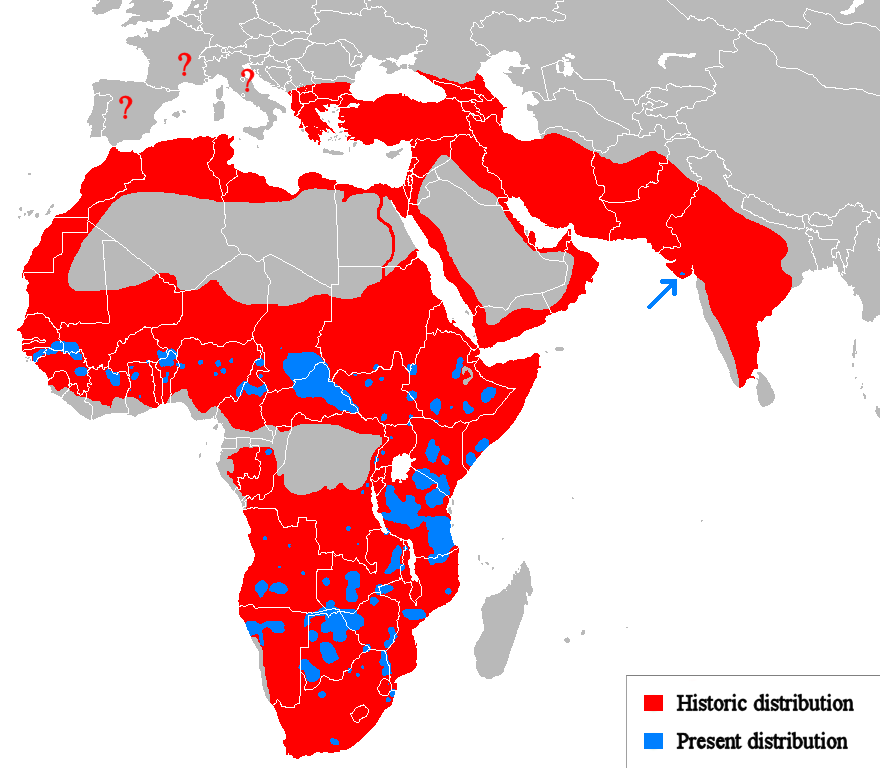|
Panthera Principialis
''Panthera principialis'' is an extinct species in big cat genus ''Panthera'' described in 2023 based on fragmentary Pliocene-aged fossils from Laetoli, Tanzania. As the species was the oldest known ''Panthera'' species at the time, it was given the specific epithet "principialis", from the Latin word meaning "initial, original, in the beginning". Taxonomy & evolution The fossils on which ''P. principialis'' was based had previously been assigned to the species ''Panthera leo'', ''Panthera gombaszoegensis ''Panthera gombaszoegensis'', also known as the European jaguar, is a ''Panthera'' species that lived from about 2.0 to 0.3 million years ago in Europe, as well as likely elsewhere in Eurasia. The first fossils were Excavation (archaeology), exca ...'', and '' Panthera palaeosinensis''. Description ''Panthera principialis'' was a lion-sized cat. References principialis principialis Pliocene carnivorans Fossil taxa described in 2023 Mammals described in 2023 {{ ... [...More Info...] [...Related Items...] OR: [Wikipedia] [Google] [Baidu] |
Pliocene
The Pliocene ( ; also Pleiocene) is the epoch (geology), epoch in the geologic time scale that extends from 5.33 to 2.58See the 2014 version of the ICS geologic time scale million years ago (Ma). It is the second and most recent epoch of the Neogene Period in the Cenozoic, Cenozoic Era. The Pliocene follows the Miocene Epoch and is followed by the Pleistocene Epoch. Prior to the 2009 revision of the geologic time scale, which placed the four most recent major glaciations entirely within the Pleistocene, the Pliocene also included the Gelasian Stage, which lasted from 2.59 to 1.81 Ma, and is now included in the Pleistocene. As with other older geologic periods, the Stratum, geological strata that define the start and end are well-identified but the exact dates of the start a ... [...More Info...] [...Related Items...] OR: [Wikipedia] [Google] [Baidu] |
Helmut Hemmer
Helmut is a German name. Variants include Hellmut, Helmuth, and Hellmuth. From old German, the first element deriving from either ''heil'' ("healthy") or ''hiltja'' ("battle"), and the second from ''muot'' ("spirit, mind, mood"). Helmut may refer to: People A–L *Helmut Angula (born 1945), Namibian politician * Helmut Ashley (1919–2021), Austrian director and cinematographer *Helmut Bakaitis (born 1944), Australian director and actor *Helmut Berger (1944–2023), Austrian actor *Helmut Dantine (1917–1982), Austrian actor * Helmut Deutsch (born 1945), Austrian classical pianist *Helmut Ditsch (born 1962), Argentine painter * Hellmut Diwald (1924–1993), German historian * Helmut Donner (born 1941), Austrian high jumper *Helmut Duckadam (1959–2024), Romanian footballer *Helmut Fischer (1926–1997), German actor * Hellmut von Gerlach (1866–1935), German journalist * Helmut Goebbels (1935–1945), only son of Joseph Goebbels * Helmut Graeb, German electrical engineer *Helmu ... [...More Info...] [...Related Items...] OR: [Wikipedia] [Google] [Baidu] |
Panthera
''Panthera'' is a genus within the family (biology), family Felidae, and one of two extant genera in the subfamily Pantherinae. It contains the largest living members of the cat family. There are five living species: the jaguar, leopard, lion, snow leopard and tiger. Numerous extinct species are also named, including the Panthera spelaea, cave lion and American lion. Etymology The word derives from Classical Latin , itself from the Ancient Greek (). Characteristics In ''Panthera'' species, the dorsal profile of the skull is flattish or evenly convex. The frontal interOrbit (anatomy), orbital area is not noticeably elevated, and the area behind the elevation is less steeply sloped. The basic Cranial cavity, cranial axis is nearly horizontal. The inner chamber of the Auditory bulla, bullae is large, the outer small. The partition between them is close to the external auditory meatus. The convexly rounded chin is sloping. All ''Panthera'' species have an incompletely ossified h ... [...More Info...] [...Related Items...] OR: [Wikipedia] [Google] [Baidu] |
Tanzania
Tanzania, officially the United Republic of Tanzania, is a country in East Africa within the African Great Lakes region. It is bordered by Uganda to the northwest; Kenya to the northeast; the Indian Ocean to the east; Mozambique and Malawi to the south; Zambia to the southwest; and Rwanda, Burundi, and the Democratic Republic of the Congo to the west. According to a 2024 estimate, Tanzania has a population of around 67.5 million, making it the most populous country located entirely south of the equator. Many important hominid fossils have been found in Tanzania. In the Stone and Bronze Age, prehistoric migrations into Tanzania included South Cushitic languages, Southern Cushitic speakers similar to modern day Iraqw people who moved south from present-day Ethiopia; Eastern Cushitic people who moved into Tanzania from north of Lake Turkana about 2,000 and 4,000 years ago; and the Southern Nilotic languages, Southern Nilotes, including the Datooga people, Datoog, who originated fro ... [...More Info...] [...Related Items...] OR: [Wikipedia] [Google] [Baidu] |
Panthera Leo
The lion (''Panthera leo'') is a large cat of the genus ''Panthera'', native to Sub-Saharan Africa and India. It has a muscular, broad-chested body; a short, rounded head; round ears; and a dark, hairy tuft at the tip of its tail. It is sexually dimorphic; adult male lions are larger than females and have a prominent mane. It is a social species, forming groups called prides. A lion's pride consists of a few adult males, related females, and cubs. Groups of female lions usually hunt together, preying mostly on medium-sized and large ungulates. The lion is an apex and keystone predator. The lion inhabits grasslands, savannahs, and shrublands. It is usually more diurnal than other wild cats, but when persecuted, it adapts to being active at night and at twilight. During the Neolithic period, the lion ranged throughout Africa and Eurasia, from Southeast Europe to India, but it has been reduced to fragmented populations in sub-Saharan Africa and one population in western ... [...More Info...] [...Related Items...] OR: [Wikipedia] [Google] [Baidu] |
Panthera Gombaszoegensis
''Panthera gombaszoegensis'', also known as the European jaguar, is a ''Panthera'' species that lived from about 2.0 to 0.3 million years ago in Europe, as well as likely elsewhere in Eurasia. The first fossils were Excavation (archaeology), excavated in 1938 in Gombasek Cave, Slovakia. ''P. gombaszoegensis'' was a medium-large sized species that formed an important part of the European carnivore guild for a period of over a million years. Many authors have posited that it is the ancestor of the American jaguar (''Panthera onca''), with some authors considering it the subspecies ''Panthera onca gombaszoegensis,'' though the close relationship between the two species has been questioned by some authors. Taxonomy ''Leo gombaszoegensis'' was the scientific name proposed by Miklós Kretzoi in 1938 for teeth found in deposits in Gombasek Cave, Slovakia. The spelling of the species name is based on the Hungarian name of Gombasek, . It was reassessed and subordinated to the Genus (biolog ... [...More Info...] [...Related Items...] OR: [Wikipedia] [Google] [Baidu] |
Panthera Palaeosinensis
''Panthera palaeosinensis'' was an early Pleistocene species from northern China. It is often incorrectly referenced as the ancestor of the tiger, ''Panthera tigris'', although it shares features with all living large cats. Recent studies place it close to the base of the genus ''Panthera ''Panthera'' is a genus within the family (biology), family Felidae, and one of two extant genera in the subfamily Pantherinae. It contains the largest living members of the cat family. There are five living species: the jaguar, leopard, lion, ...''. ''Panthera palaeosinensis'' was first described in 1924 as ''Felis paleosinensis'' by Otto Zdansky in his work "Jungtertiäre Carnivoren Chinas". The dating is not certain, but estimates place it around the Plio-Pleistocene boundary at two to three million years old. ''Panthera paleosinensiss skull has an A-P length of and a mandibular length of and the living creature would have appeared like a jaguar, stout and strong. The conical upper ca ... [...More Info...] [...Related Items...] OR: [Wikipedia] [Google] [Baidu] |
Prehistoric Pantherines
Prehistory, also called pre-literary history, is the period of human history between the first known use of stone tools by hominins million years ago and the beginning of recorded history with the invention of writing systems. The use of symbols, marks, and images appears very early among humans, but the earliest known writing systems appeared years ago. It took thousands of years for writing systems to be widely adopted, with writing having spread to almost all cultures by the 19th century. The end of prehistory therefore came at different times in different places, and the term is less often used in discussing societies where prehistory ended relatively recently. It is based on an old conception of history that without written records there could be no history. The most common conception today is that history is based on evidence, however the concept of prehistory hasn't been completely discarded. In the early Bronze Age, Sumer in Mesopotamia, the Indus Valley Civilis ... [...More Info...] [...Related Items...] OR: [Wikipedia] [Google] [Baidu] |
Pliocene Carnivorans
The Pliocene ( ; also Pleiocene) is the epoch in the geologic time scale that extends from 5.33 to 2.58See the 2014 version of the ICS geologic time scale million years ago (Ma). It is the second and most recent epoch of the Period in the . The Pliocene follows the Epoch and is followed by the |
Fossil Taxa Described In 2023
A fossil (from Classical Latin , ) is any preserved remains, impression, or trace of any once-living thing from a past geological age. Examples include bones, shells, exoskeletons, stone imprints of animals or microbes, objects preserved in amber, hair, petrified wood and DNA remnants. The totality of fossils is known as the ''fossil record''. Though the fossil record is incomplete, numerous studies have demonstrated that there is enough information available to give a good understanding of the pattern of diversification of life on Earth. In addition, the record can predict and fill gaps such as the discovery of ''Tiktaalik'' in the arctic of Canada. Paleontology includes the study of fossils: their age, method of formation, and evolutionary significance. Specimens are sometimes considered to be fossils if they are over 10,000 years old. The oldest fossils are around 3.48 billion years to 4.1 billion years old. Early edition, published online before print. The ob ... [...More Info...] [...Related Items...] OR: [Wikipedia] [Google] [Baidu] |




